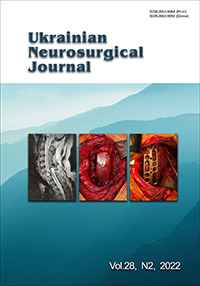Mine blast injury of the spine and spinal cord: a case report
DOI:
https://doi.org/10.25305/unj.257985Keywords:
mine blast injury, spinal cord injury, cervical spine injuryAbstract
Many soldiers who were wounded during the war in Ukraine with Russia increased the number of cases of spinal injury.
As a result of the Russia-Ukraine war, the number of patients with spine and spinal cord injuries increased significantly.
According to the literature, gunshot wounds to the spine and spinal cord accounted for 0.26% of all soldier injuries during the American Civil War, with a mortality rate of 55%. According to the U.S. military data, spinal and spinal cord injuries accounted for 1.2% of war-related deaths during the Korean War, 1.0% - during the Vietnam War and the Gulf War, 6.0% - during the US invasion of Panama, 11.1% - during the war in Afghanistan and Iraq. Disability related to spinal cord injuries (14.0%) is currently the leading cause of discharge from military service for U.S. soldiers who have been injured.
Patient M., 32 years old, male sustained mine blast injury. Immediately after the injury there was tetraplegia.
Surgery was performed to correct vertebrae С7–Тh1, decompression of the spinal cord at the level of vertebrae С7–Тh1. Sixteen days after surgery, the neurological deficit regressed to the Frankel C clinical group. The patient was transferred to rehabilitation treatment.
A clear, consistent, rapid algorithm of action in spinal cord injuries allowed to provide highly qualified care, which allowed to achieve significant results in the regression of neurological deficits in the postoperative period.
References
Furlan JC, Gulasingam S, Craven BC. Epidemiology of War-Related Spinal Cord Injury Among Combatants: A Systematic Review. Global Spine J. 2019 Aug;9(5):545-558. doi: 10.1177/2192568218776914.
Furlan JC, Gulasingam S, Craven BC. The Health Economics of the spinal cord injury or disease among veterans of war: A systematic review. J Spinal Cord Med. 2017 Nov;40(6):649-664. doi: 10.1080/10790268.2017.1368267.
Blackbourne LH, Baer DG, Eastridge BJ, Kheirabadi B, Bagley S, Kragh JF Jr, Cap AP, Dubick MA, Morrison JJ, Midwinter MJ, Butler FK, Kotwal RS, Holcomb JB. Military medical revolution: prehospital combat casualty care. J Trauma Acute Care Surg. 2012 Dec;73(6 Suppl 5):S372-7. doi: 10.1097/TA.0b013e3182755662. Erratum in: J Trauma Acute Care Surg. 2013 Feb;74(2):705. Kotwal, Russell S [corrected to Kotwal, Russ S]. Erratum in: J Trauma Acute Care Surg. 2013 Jan;74(1):347. Bagley, Stephanie [added]. PMID: 23192058.
Downloads
Published
How to Cite
Issue
Section
License
Copyright (c) 2022 Ievgenii I. Slynko, Yurii V. Derkach, Arthur I. Ermolev, Oleksii S. Nekhlopochyn, David A. Tavzadze

This work is licensed under a Creative Commons Attribution 4.0 International License.
Ukrainian Neurosurgical Journal abides by the CREATIVE COMMONS copyright rights and permissions for open access journals.
Authors, who are published in this Journal, agree to the following conditions:
1. The authors reserve the right to authorship of the work and pass the first publication right of this work to the Journal under the terms of Creative Commons Attribution License, which allows others to freely distribute the published research with the obligatory reference to the authors of the original work and the first publication of the work in this Journal.
2. The authors have the right to conclude separate supplement agreements that relate to non-exclusive work distribution in the form of which it has been published by the Journal (for example, to upload the work to the online storage of the Journal or publish it as part of a monograph), provided that the reference to the first publication of the work in this Journal is included.









